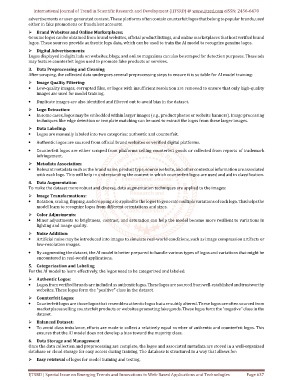Page 647 - Emerging Trends and Innovations in Web-Based Applications and Technologies
P. 647
International Journal of Trend in Scientific Research and Development (IJTSRD) @ www.ijtsrd.com eISSN: 2456-6470
advertisements or user-generated content. These platforms often contain counterfeit logos that belong to popular brands, used
either in fake promotions or fraudulent accounts.
Brand Websites and Online Marketplaces:
Genuine logos can be obtained from brand websites, official product listings, and online marketplaces that host verified brand
logos. These sources provide authentic logo data, which can be used to train the AI model to recognize genuine logos.
Digital Advertisements:
Logos displayed in digital ads on websites, blogs, and online magazines can also be scraped for detection purposes. These ads
may feature counterfeit logos used to promote fake products or services.
3. Data Preprocessing and Cleaning
After scraping, the collected data undergoes several preprocessing steps to ensure it is suitable for AI model training:
Image Quality Filtering:
· Low-quality images, corrupted files, or logos with insufficient resolution are removed to ensure that only high-quality
images are used for model training.
· Duplicate images are also identified and filtered out to avoid bias in the dataset.
Logo Extraction:
· In some cases, logos may be embedded within larger images (e.g., product photos or website banners). Image processing
techniques like edge detection or template matching can be used to extract the logos from these larger images.
Data Labeling:
· Logos are manually labeled into two categories: authentic and counterfeit.
· Authentic logos are sourced from official brand websites or verified digital platforms.
· Counterfeit logos are either scraped from platforms selling counterfeit goods or collected from reports of trademark
infringement.
Metadata Association:
· Relevant metadata such as the brand name, product type, source website, and other contextual information are associated
with each logo. This will help in understanding the context in which counterfeit logos are used and aid in classification.
4. Data Augmentation
To make the dataset more robust and diverse, data augmentation techniques are applied to the images:
Image Transformations:
· Rotation, scaling, flipping, and cropping are applied to the logos to generate multiple variations of each logo. This helps the
model learn to recognize logos from different orientations and sizes.
Color Adjustments:
· Minor adjustments to brightness, contrast, and saturation can help the model become more resilient to variations in
lighting and image quality.
Noise Addition:
· Artificial noise may be introduced into images to simulate real-world conditions, such as image compression artifacts or
low-resolution images.
· By augmenting the dataset, the AI model is better prepared to handle various types of logos and variations that might be
encountered in real-world applications.
5. Categorization and Labeling
For the AI model to learn effectively, the logos need to be categorized and labeled:
Authentic Logos:
· Logos from verified brands are included as authentic logos. These logos are sourced from well-established and trustworthy
websites. These logos form the "positive" class in the dataset.
Counterfeit Logos:
· Counterfeit logos are those logos that resemble authentic logos but are subtly altered. These logos are often sourced from
marketplaces selling counterfeit products or websites promoting fake goods. These logos form the "negative" class in the
dataset.
Balanced Dataset:
· To avoid class imbalance, efforts are made to collect a relatively equal number of authentic and counterfeit logos. This
ensures that the AI model does not develop a bias toward the majority class.
6. Data Storage and Management
Once the data collection and preprocessing are complete, the logos and associated metadata are stored in a well-organized
database or cloud storage for easy access during training. The database is structured in a way that allows for:
Easy retrieval of logos for model training and testing.
IJTSRD | Special Issue on Emerging Trends and Innovations in Web-Based Applications and Technologies Page 637

